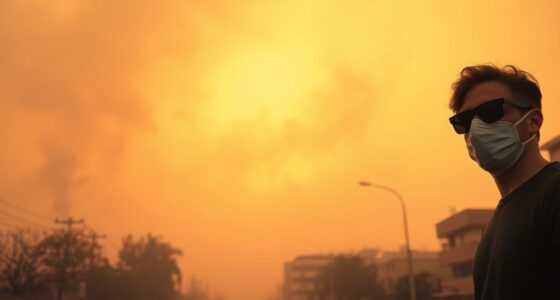I understand that N95, KN95, and FFP2 masks each meet strict filtration standards, confirmed through rigorous certification processes by agencies like NIOSH and CE. These masks are tested to guarantee they filter out at least 94-95% of airborne particles and fit properly to provide effective protection. Proper fit is essential for maximum efficacy, and certified masks are more reliable. Keep exploring to learn how to choose and wear them for the best protection.
Key Takeaways
- N95, KN95, and FFP2 masks must meet specific filtration standards (95%, 94%, and 94%, respectively) for airborne particles.
- Proper fit is essential; masks should form a seal around the face to maximize filtration efficiency.
- Certification by agencies like NIOSH (N95) and CE (FFP2) ensures masks meet rigorous safety and performance standards.
- Fit testing and correct sizing improve mask effectiveness and comfort during use.
- Understanding the standards helps select masks that provide genuine protection and reliable filtration.

As the demand for effective respiratory protection grows, understanding the standards behind N95, KN95, and FFP2 masks becomes essential. These masks are designed to filter out airborne particles, but not all masks are created equal. The key to their effectiveness lies in their filter efficiency and the certification process they undergo before reaching consumers. Filter efficiency refers to how well a mask can block particles, including viruses, bacteria, and dust. N95 masks, for example, are required to filter out at least 95% of airborne particles that are 0.3 microns in size. Similarly, FFP2 masks must filter at least 94%, and KN95 masks are expected to meet a comparable standard of 95%. These percentages aren’t arbitrary; they’re dictated by rigorous testing protocols during the certification process, which ensures each mask performs consistently and reliably.
During the certification process, masks are subjected to specific tests that measure their filter efficiency under controlled conditions. These tests simulate real-world exposure to airborne particles, verifying that the masks can maintain their filtration capacity over time. It’s not just about initial performance; standards also consider factors like breathability and fit, ensuring that users can wear the masks comfortably without sacrificing protection. The certification process is carried out by recognized agencies—such as NIOSH for N95s in the United States or CE for FFP2 masks in Europe—each with strict guidelines to guarantee quality and performance. When a mask passes these tests, it receives official certification, which means it meets the necessary safety standards.
Additionally, understanding the certification process helps distinguish masks that genuinely offer high-level protection from counterfeit or substandard options. Knowing that a mask has gone through a thorough certification process gives me confidence in its ability to protect me and those around me. It also underscores the importance of choosing masks from reputable suppliers who adhere to these standards. Ultimately, the combination of high filter efficiency and a rigorous certification process is what guarantees a mask’s performance, making it a crucial consideration when selecting respiratory protection.
Frequently Asked Questions
How Often Should I Replace My Mask for Optimal Protection?
I recommend replacing your mask after each use or if it becomes damp, so it stays effective. Proper mask storage is key—keep it in a clean, dry place between wears. If the mask is visibly dirty or damaged, dispose of it immediately. Regular mask disposal helps maintain protection and prevents contamination. Always follow manufacturer guidelines for specific mask types to guarantee maximum protection every time you wear it.
Can I Reuse N95, KN95, or FFP2 Masks Safely?
Think of your mask as a trusted ally—its strength lies in safety, but only if cared for properly. Yes, you can reuse N95, KN95, or FFP2 masks with proper sterilization and careful mask storage. I recommend using methods like UV sterilization or mask steaming, and always storing masks in a clean, dry place. Just remember, the integrity of your mask is key to maintaining its protective shield.
Are These Masks Effective Against All Airborne Viruses?
These masks markedly reduce airborne virus transmission, but no mask is foolproof against all airborne viruses. Their effectiveness depends on mask material efficacy—filtration layers that block tiny particles. While N95, KN95, and FFP2 masks are highly effective for most airborne viruses, some extremely small or airborne viruses might still pass through. Wearing them correctly and consistently boosts your protection, but understanding their limits helps you stay safer.
How Do I Ensure a Proper Seal With These Masks?
To make certain of a proper seal with these masks, I first adjust the strap tension so it fits snugly without causing discomfort. I then mold the mask to my facial contour, pressing gently around the nose and cheeks. I check for gaps by inhaling sharply and feeling for air leaks. This helps me get a secure fit, maximizing protection and comfort every time I wear it.
Do Different Brands Meet the Same Safety Standards?
Ever wonder if different brands meet the same safety standards? I’ve found that while many brands claim compliance, brand consistency isn’t always guaranteed. The key is certification verification—check for official marks like NIOSH, CE, or equivalent. These ensure the mask has undergone proper testing. Don’t just trust a brand; confirm its certification to make sure you’re getting reliable protection, no matter the label.
Conclusion
I know some might think all masks are the same, but understanding the differences between N95, KN95, and FFP2 helps you stay safer. Proper fit is just as vital as the mask type itself, so don’t skip adjusting or testing your mask’s seal. Trust me, taking a moment to guarantee your mask fits correctly can make all the difference in protecting you and those around you. Your safety is worth the extra effort!









